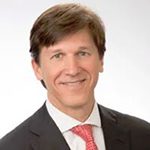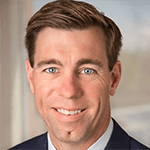By: Lisa Shidler, Feb. 6, 2019 /RIABiz.com/
Dan Arnold steers Fort Mill, S.C. IBD giant on walk-and-chew-gum course that allows for juicing annuity sales, rebuilding RIA fee platform and squeezing more profits from less revenue.
Brooke’s Note: Sometimes share prices are misleading. More often, not. LPL gets lots of critical media because of the wrenching change it is undergoing and its Goliath standing as an IBD. So you might think its shares would be swooning. Not at all. LPL is losing a few battles along the way. But the battle of winning value for shareholders is looking up as it begins to solve problems for advisors and shares spike. Its future suddenly looks brighter under a very dynamic new leadership trio of Arnold, Audette and Steinmeier.

LPL Financial stock soared to an all-time of $77 a share, Feb. 5, on a resounding Wall Street verdict that Dan Arnold gets recruiting, OSJ relations and letting brokers-be-brokers as the Fiduciary Rule regulatory storm calms.
The Fort Mill, S.C. broker-dealer’s shares spiked 10%, from about $70, after reporting higher earnings in its Q4 and full-year earnings report last month. Shares closed today (Feb. 6) at $76.71, amid some probable profit-taking.
CEO Arnold also offered analysts plausible reasons why the best may be yet to come. The market cap hit a cool $6.6 billion.
Not only have shares more than doubled the $32.90 IPO price in 2010, but are trading at near four times the price when the stock hit rock bottom, $22 a share, in Dec. 2014.
Former CEO Mark Casady announced he was leaving on Dec. 5, 2016, when the stock price hovered around $32 a share. Arnold took the helm as CEO in early 2017. See: LPL replaces the great Bill Morrissey with UBS’ digital whiz
LPL’s 2018 profits were 26% higher than 2017, due, in part, to higher interest rates. The post-Department of Labor (DOL) Fiduciary Rule environment allows LPL stockbrokers to do what brokers do best — sell commission-based products.
“You’ve seen quite frankly some stability in both the brokerage flows and the sales-based commissions really over the past three quarters,” Arnold says.
He adds: “I think, you also see, with maybe some progress on the regulatory front, more willingness to use brokerage with existing — existing advisors using brokerage as a potential solution to help clients, and I think that’s certainly been a contributor.”

Smoothing Wrinkles
But LPL isn’t just smoothing out wrinkles on the classic brokerage side of the ledger. It also smoothed out relations with mega-AUM OSJ principals like John Hyland, co-founder of Private Advisor Group, whose RIA managed $16.5 billion at the end of 2018.
LPL in the fourth quarter of 2018 relaxed a requirement that advisors had to have $50 million in advisory assets to join a hybrid.
And, earlier this year, LPL opened itself up to become a “friendly broker-dealer,” by inking a deal with Private Advisor Group, Hyland explains.
The deal means its Private Advisor Group can recruit an advisor from another firm, When that advisor comes, the advisor isn’t required to custody any assets at LPL and won’t have to pay any fees. See: Tensions build with OSJs after LPL Financial’s ‘about face’ on held-away RIA assets and forced use of its corporate RIA
“With the new platform, there is no oversight fee. If an advisor came to Merrill and wanted LPL to be the broker, but wanted to custody all of the assets at Schwab, it’s no problem. There are no extra costs,” Hyland says.
Steinmeier replaced longtime sales chief Bill Morrissey after a period of slowed recruiting. See: LPL replaces the great Bill Morrissey with UBS’ digital whiz
And, LPL suffered the announcement of Bill Hamm’s departure last year. See: As Independent Financial Partners readies its $41-billion LPL breakaway, a third CEO goes for the jugular
Bullish Turn

LPL also struggled in 2018 to gain the NPH advisors, but it looks like the giant broker-dealer is on the road to recovery with its recruiting, says Louis Diamond, principal of Diamond Consulting.
“I’m much more bullish on LPL’s recruiting now than in the past. They are clearly the scale player in the IBD world, and we’ve watched so many acquisitions of smaller broker dealers because they couldn’t remain competitive like LPL,” he says.
There is no question that 2018 saw major bumps in the road, Diamond notes.
“They’re not foolish. They saw they lost a lot of recruits and had a lot of negative feedback. It seems they are making the right moves to enhance their value proposition to recruit and keep the largest firms with them.”
Thanks to NFP, the broker-dealer actually ended 2018 with 16,109 advisors, a net gain of 899 up from 15,210 at the end of 2017.
Recruiting is an area where LPL could have an even better year, says Ryan Shanks, principal of Finetooth Consulting. “They have been very aggressive in recruiting, and 2019 could be one of their most aggressive years yet.”
Interest rates and a plain vanilla strategy to keep costs in line have been successful for LPL, Arnold said last week during an earnings call.
Fourth quarter revenue was $1.3 billion, missing analysts’ expectations by $40 million. On the upside, the numbers showed LPL was able to do more with less. See:
Gross profit was $508 million, up $15 million, or 3%, sequentially from the third quarter ended Sept. 30, primarily driven by increases in cash-sweep and transaction revenues.
Cash balances were $34.9 billion, up $6.7 billion from Sept. 30 and yield was 240 basis points, up 26 basis points from the third quarter — a recipe for soaking up profits that made one analyst squeal.
“Certainly, the 240 basis points guide was a nice surprise,” said Steve Chubak, a Wolfe Research analyst on the Q4 call. See: LPL Financial wages ‘war’ on Cetera, Securities America and Kestra after they pounced on NPH advisors in wake of sale

M&A Likely
Coming off of NPH, LPL is not likely to roll-up other IBDs as a chief source of growth. But M&A is more likely for improving the firm’s ability to increase advisor productivity, Matthew J. Audette, managing director and chief financial officer, said on the call. See: LPL Financial wages ‘war’ on Cetera, Securities America and Kestra after they pounced on NPH advisors in wake of sale
“I think the investments in allocating capital for organic growth, we think, is by far the best return on capital. We’ll do things like you saw us do with AdvisoryWorld this quarter. We can do a capability acquisition that helps move the strategy forward.” See: LPL Financial’s $28 million cash purchase of AdvisoryWorld solves one big problem: Now it can make sure the proposal software includes annuities in its proposals
Audette explains his firm’s willingness to yield on fees: “This pricing investment will reduce gross profit by about $2 million per quarter initially. Over time, we believe the improved pricing will attract additional assets to our platform which would offset the cost at this investment.”
The power of attractive pricing was evident on the highly publicized changes going on at IFP — the breakaway OSJ.
“If you look at the assets, IFP started out this process at around $12 billion of brokerage and advisory assets,” he said on the call. “To date, the advisors, who manage about two-thirds of those assets, have made the decision, and approximately 75% of those assets are staying with us.”
In another positive move, LPL is tweaking its pricing for RIAs, Diamond says. The company hired Marc Cohen form MarketCounsel last fall, another move that shows LPL is focused on the RIA arena.
Marc Cohen Cometh

“I think they’re embracing the outside RIA as opposed to running away from it. Marc is working to build out a more competitive RIA offering,” Diamond says.
Asked by an analyst whether LPL will follow the lead of Commonwealth and Cambridge Investment Reseach by having a more “RIA” custody offering, Arnold offered a qualified “yes.” See: Commonwealth and Cambridge jump into RIA custody game bigger
“We have a solution today,” he said. “What I would tell you though is the question we’re challenging ourselves on is can we improve it? Can we re-transform it? Can we materially rethink it such that we re-position it into a more compelling and competitive offering out in the marketplace?” See: LPL Financial pushes toward full-service-on-tap model with its ‘virtual’ play — running some real risks in the process
“So we’re in the process of doing just that. So more to come on that, but we do think it’s an interesting possibility that we should be considering relative improving and enhancing our offering today.”
Believe it, Hyland says.
“There is a great momentum shift at LPL,” he says. “They’re thinking differently and their communication to large enterprises like ours has been night-and-day from the past,” he said. “It’s been a really good year and a half. The leadership is looking at the future differently than previous leaderships.”